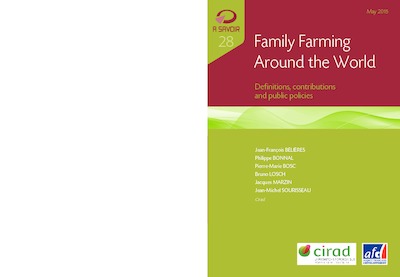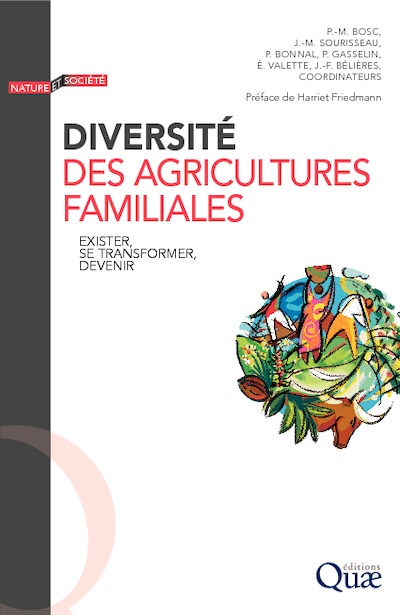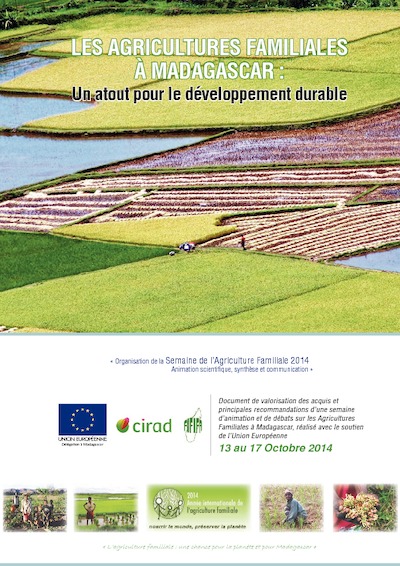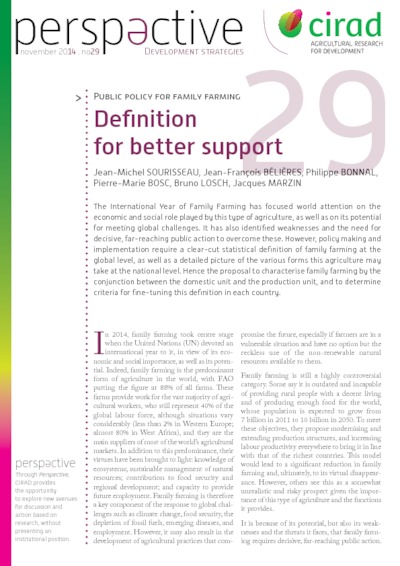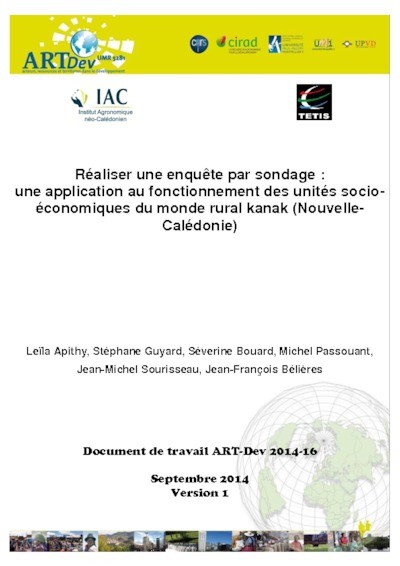In December 2011, the sixty-sixth session of the United Nations General Assembly decided to designate 2014 as the “International Year of Family Farming”. The resolution “encourages member States to undertake activities within their respective national development programmes in support of the International Year of Family Farming”.This publication responds to a request from AFD, the Ministry of Foreign Affairs and International Development (MAEDI) and the Ministry of Agriculture, Agrifood and Forestry (MAAF)[ 1 ]. It provides an overview of the debates about and around family farming , its place, its roles in the issues and challenges of agriculture at the beginning of this 21st century, and its inclusion in public polices. It aims, more modestly, and following on from the declaration of the International Year of Family Farming , to determine some of the knowledge acquired in order to gain a better understanding of this category of “family farming”, which is multifaceted and much less defined than its mobilisation in current debates might suggest. Indeed, one might assume that everything has already been said and written about this form of farming , as it has been widely analysed and discussed by professional and trade union organisations, research, public administration, development actors and political bodies and, as a result, find the renewed interest in it surprising. Yet it has to be recognised that the changes taking place in agriculture and agrifood systems worldwide – some of which figure prominently in the media, such as large-scale land grabbing or the restructuring of agrifood chains – raise the question of its viability. They call for a re-examining of family farms in all their diversity and ultimat
FAMILY FARMING AROUND THE WORLD Definitions, contributions and public policies
DIVERSITE DES AGRICULTURES FAMILIALES Exister, se transformer, devenir
Cet ouvrage est le produit d'un itinéraire collectif. Son point de départ est une interrogation partagée sur les formes familiales de production agricole et sur la manière de les nommer. Il se fonde sur le constat du décalage croissant entre nos représentations, souvent historiquement datées et des réalités agraires et urbaines en mouvement permanent, avec une circulation instantanée des informations entre ces mondes habituellement plus distants. Son apport est de révéler la diversité des formes familiales de par le monde. Chacun des auteurs porte son regard sur une forme particulière d'agriculture familiale. Car une des caractéristiques des agricultures familiales est bien leur capacité à mettre en valeur aussi bien des milieux favorables à la production agricole que des milieux à fortes contraintes où les formes patronales et entreprenariales d'agriculture ne se risquent pas. Les systèmes productifs mis au point dans ces environnements témoignent de capacités d'innovation exceptionnelles qui, dans certains cas, atteignent leurs limites du fait des pressions d'ordre écologique ou économique. C'est cette extrême diversité que nous avons souhaité éclairer dans cet ouvrage depuis les plateaux du Tibet, les Andes équatoriennes, les interstices agricoles du Caire, les plantations de palmier à huile en Indonésie, les champs d'igname kanak, les confins de la Pologne orientale, les parcours sahaliens du Niger, les cacaoyères du Cameroun, les savanes du Mali ou du centre Bénin.
DIVERSITE DES AGRICULTURES FAMILIALES Exister, se transformer, devenir
Cet ouvrage est le produit d’un itinéraire collectif. Son point de départ est une interrogation partagée sur les formes familiales de production agricole et sur la manière de les nommer. Il se fonde sur le constat du décalage croissant entre nos représentations, souvent historiquement datées, et des réalités agraires et urbaines en mouvement permanent, avec une circulation instantanée des informations entre ces mondes habituellement plus distants. Son apport est de révéler la diversité des formes familiales de par le monde Chacun des auteurs porte son regard sur une forme particulière d’agriculture familiale Car une des caractéristiques des agricultures familiales est bien leur capacité à mettre en valeur aussi bien des milieux favorables à la production agricole que des milieux à fortes contraintes où les formes patronales et entrepreneuriales d’agriculture ne se risquent pas Les systèmes productifs mis au point dans ces environnements témoignent de capacités d’innovation exceptionnelles qui, dans certains cas, atteignent leurs limites du fait des pressions d’ordre écologique ou économique C’est cette extrême diversité que nous avons souhaité éclairer dans cet ouvrage, depuis les plateaux du Tibet, les Andes équatoriennes, les interstices agricoles du Caire, les plantations de palmier à huile en Indonésie, les champs d’igname kanak, les confins de la Pologne orientale, les parcours sahéliens du Niger, les cacaoyères du Cameroun, les savanes du Mali ou du centre Bénin.
LES AGRICULTURES FAMILIALES A MADAGASCAR: Un atout pour le développement durable
En déclarant 2014 Année Internationale de l'Agriculture Familiale (AIAF), l'ONU a voulu attirer l'attirer du monde entier sur cette forme d'organisation de la production agricole qui constitue le type d'agriculture le plus représenté sur la planète.
Public policy for family farming Definition for better support
The International Year of Family Farming has focused world attention on the economic and social role played by this type of agriculture, as well as on its potential for meeting global challenges. It has also identified weaknesses and the need for decisive, far-reaching public action to overcome these. However, policy making and implementation require a clear-cut statistical definition of family farming at the global level, as well as a detailed picture of the various forms this agriculture may take at the national level. Hence the proposal to characterise family farming by the conjunction between the domestic unit and the production unit, and to determine criteria for fine-tuning this definition in each country.
Politiques publiques pour l'agriculture familiale- Caractériser pour mieux soutenir
L’année internationale de l’agriculture familiale a médiatisé le rôle économique et social que joue ce type d’agriculture, ainsi que ses atouts pour relever les défis globaux. Elle a soulevé aussi des fragilités et la nécessité d’une action publique déterminée et d’ampleur pour les dépasser. Or, l’élaboration et la mise en œuvre de politiques publiques nécessitent une définition précise et statistique de l’agriculture familiale à l’échelle mondiale, et aussi une image fine des différentes formes que prend cette agriculture à l’échelle nationale. D’où la proposition de caractériser l’agriculture familiale par la conjonction entre unité domestique et unité de production, et de définir des critères pour affiner cette définition dans chaque pays.
Réaliser une enquête par sondage: une application au fonctionnement des unités socio-économiques du monde rural kanak (Nouvelle Calédonie)
À travers la description fine du déroulement d’une enquête réalisée en Nouvelle-Calédonie, cette contribution vise à expliciter les pratiques et savoir-faire acquis pour enrichir les réflexions sur les méthodologies d’enquêtes agricoles, notamment Aux Suds. Il s’agit de détailler les différentes étapes d’une grande enquête par questionnaire: formulation de la problématique, définition de la population concernée, construction de l’échantillon, du questionnaire, mobilisation des outils informatiques, organisation de la collecte de données, du contrôle, de la correction et enfin, le traitement des données, les analyses et la valorisation des résultats. Les réflexions et l’importance apportées à chaque étape ont permis d’obtenir des données originales sur les activités menées par les familles rurales kanak. Surtout, les efforts menés pour adapter l’ensemble de l’enquête à la complexité locale a permis de renseigner sur le rôle crucial joué par ces activités dans l’alimentation, d’évaluer les pratiques de commercialisation de certains produits et d’alimenter la réflexion sur les fonctions sociales et symboliques des activités agricoles et de prélèvements.
